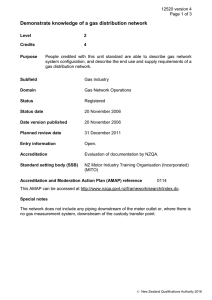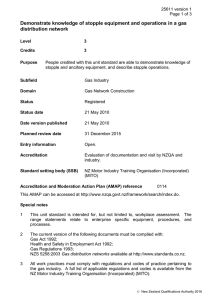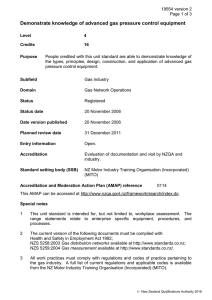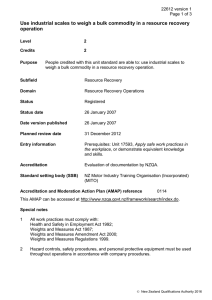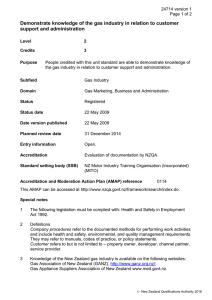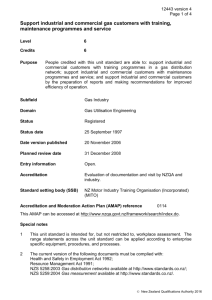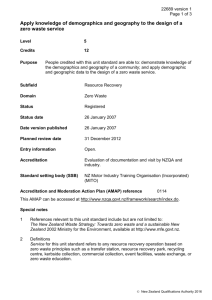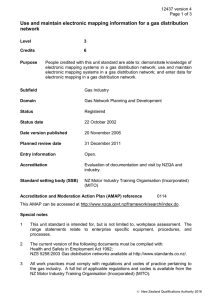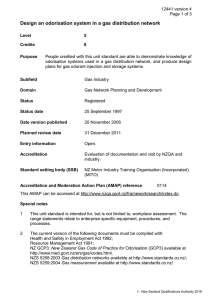Identify and utilise the principles of gas flow dynamics for... system design
advertisement
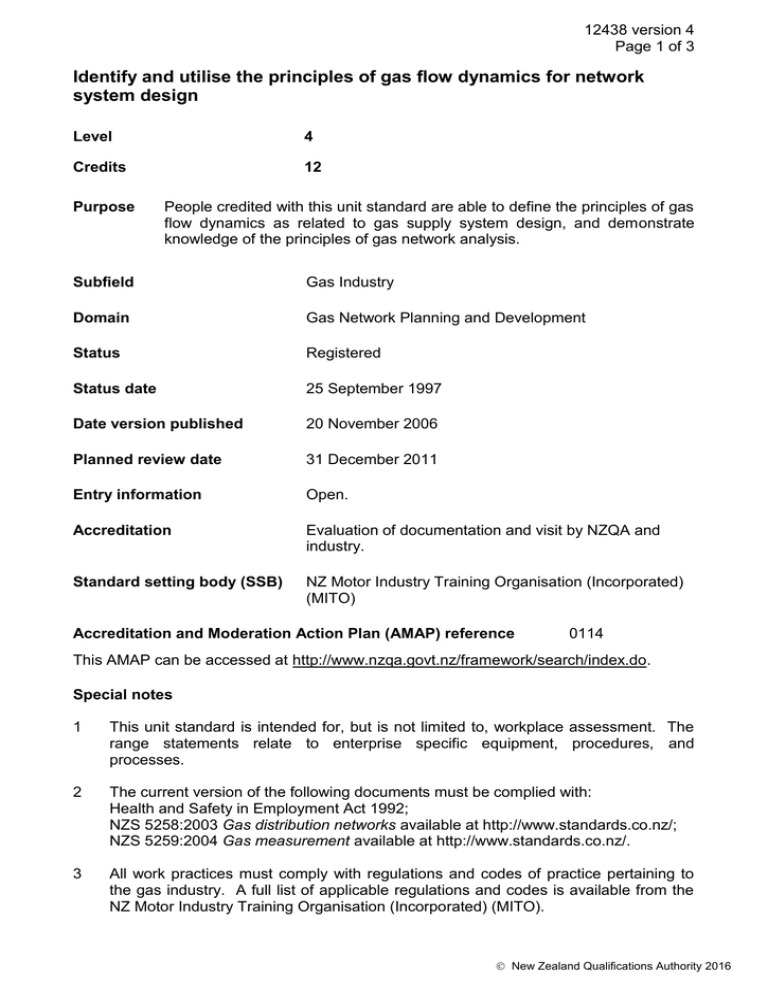
12438 version 4 Page 1 of 3 Identify and utilise the principles of gas flow dynamics for network system design Level 4 Credits 12 Purpose People credited with this unit standard are able to define the principles of gas flow dynamics as related to gas supply system design, and demonstrate knowledge of the principles of gas network analysis. Subfield Gas Industry Domain Gas Network Planning and Development Status Registered Status date 25 September 1997 Date version published 20 November 2006 Planned review date 31 December 2011 Entry information Open. Accreditation Evaluation of documentation and visit by NZQA and industry. Standard setting body (SSB) NZ Motor Industry Training Organisation (Incorporated) (MITO) Accreditation and Moderation Action Plan (AMAP) reference 0114 This AMAP can be accessed at http://www.nzqa.govt.nz/framework/search/index.do. Special notes 1 This unit standard is intended for, but is not limited to, workplace assessment. The range statements relate to enterprise specific equipment, procedures, and processes. 2 The current version of the following documents must be complied with: Health and Safety in Employment Act 1992; NZS 5258:2003 Gas distribution networks available at http://www.standards.co.nz/; NZS 5259:2004 Gas measurement available at http://www.standards.co.nz/. 3 All work practices must comply with regulations and codes of practice pertaining to the gas industry. A full list of applicable regulations and codes is available from the NZ Motor Industry Training Organisation (Incorporated) (MITO). New Zealand Qualifications Authority 2016 12438 version 4 Page 2 of 3 4 Definition Company procedures means the documented methods for performing work activities and include health and safety, environmental, and quality management requirements. They may refer to manuals, codes of practice, or policy statements. Elements and performance criteria Element 1 Define the principles of gas flow dynamics as related to gas supply system design. Performance criteria 1.1 The principles of flow are defined and related to intermediate, medium, and low pressure gas supply systems design in accordance with industry usage and system application. Range 1.2 laminar, turbulent, streamline. The principles and causes of pressure loss in a gas network are defined and related to gas supply systems design in accordance with industry usage and system application. Range length of pipe, quantity of gas flowing, diameter of pipe, specific gravity of gas, friction losses, diversity factor. 1.3 The principles of gas flow load characteristics analysis are defined and related to gas supply systems design in accordance with company procedures and system application. 1.4 Formulae relating to calculations for gas flow dynamics are explained and their use is demonstrated in accordance with industry usage and system application. Range Bernoulli's theorem, flow in pipes and Reynold’s number, Darcy’s equation, Poiseuille's law, isothermal flow, AGA equations, Weymouth equation, Panhandle A equation. Element 2 Demonstrate knowledge of the principles of gas network analysis. Performance criteria 2.1 The purpose of gas network analysis is explained in terms of industry practice and company procedures. 2.2 Data elements of network analysis are identified and explained in terms of their effect on the network. Range node identification, pipe sizes and length, demand, source, point loads, pipe configuration and resistances, supply pressure. New Zealand Qualifications Authority 2016 12438 version 4 Page 3 of 3 2.3 The principles of Kirchoff’s laws are explained in terms of application to gas network analysis. 2.4 Methods of network analysis used are explained and their use is demonstrated in terms of application, practicality, accuracy, and usage. Range cut and try, Hardy Cross, computer programmes, Mear’s gas flow calculator. Please note Providers must be accredited by the Qualifications Authority, or an inter-institutional body with delegated authority for quality assurance, before they can report credits from assessment against unit standards or deliver courses of study leading to that assessment. Industry Training Organisations must be accredited by the Qualifications Authority before they can register credits from assessment against unit standards. Accredited providers and Industry Training Organisations assessing against unit standards must engage with the moderation system that applies to those standards. Accreditation requirements and an outline of the moderation system that applies to this standard are outlined in the Accreditation and Moderation Action Plan (AMAP). The AMAP also includes useful information about special requirements for organisations wishing to develop education and training programmes, such as minimum qualifications for tutors and assessors, and special resource requirements. Comments on this unit standard Please contact the NZ Motor Industry Training Organisation (Incorporated) (MITO) info@mito.org.nz if you wish to suggest changes to the content of this unit standard. New Zealand Qualifications Authority 2016



